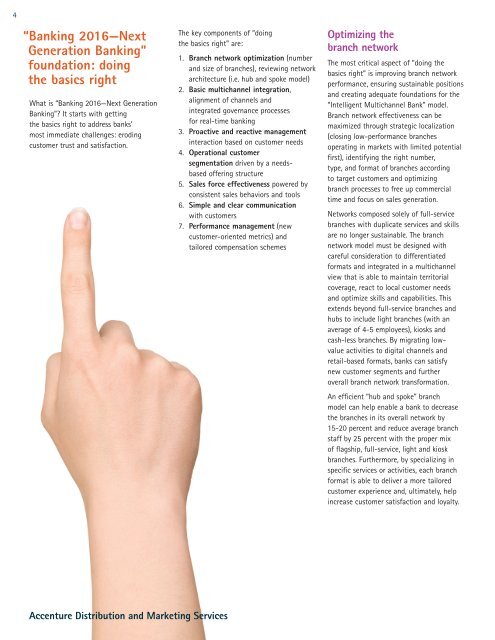hTca1
hTca1
hTca1
Create successful ePaper yourself
Turn your PDF publications into a flip-book with our unique Google optimized e-Paper software.
4<br />
“Banking 2016—Next<br />
Generation Banking”<br />
foundation: doing<br />
the basics right<br />
What is “Banking 2016—Next Generation<br />
Banking”? It starts with getting<br />
the basics right to address banks’<br />
most immediate challenges: eroding<br />
customer trust and satisfaction.<br />
The key components of “doing<br />
the basics right” are:<br />
Accenture Distribution and Marketing Services<br />
1. Branch network optimization (number<br />
and size of branches), reviewing network<br />
architecture (i.e. hub and spoke model)<br />
2. Basic multichannel integration,<br />
alignment of channels and<br />
integrated governance processes<br />
for real-time banking<br />
3. Proactive and reactive management<br />
interaction based on customer needs<br />
4. Operational customer<br />
segmentation driven by a needsbased<br />
offering structure<br />
5. Sales force effectiveness powered by<br />
consistent sales behaviors and tools<br />
6. Simple and clear communication<br />
with customers<br />
7. Performance management (new<br />
customer-oriented metrics) and<br />
tailored compensation schemes<br />
Optimizing the<br />
branch network<br />
The most critical aspect of “doing the<br />
basics right” is improving branch network<br />
performance, ensuring sustainable positions<br />
and creating adequate foundations for the<br />
“Intelligent Multichannel Bank” model.<br />
Branch network effectiveness can be<br />
maximized through strategic localization<br />
(closing low-performance branches<br />
operating in markets with limited potential<br />
first), identifying the right number,<br />
type, and format of branches according<br />
to target customers and optimizing<br />
branch processes to free up commercial<br />
time and focus on sales generation.<br />
Networks composed solely of full-service<br />
branches with duplicate services and skills<br />
are no longer sustainable. The branch<br />
network model must be designed with<br />
careful consideration to differentiated<br />
formats and integrated in a multichannel<br />
view that is able to maintain territorial<br />
coverage, react to local customer needs<br />
and optimize skills and capabilities. This<br />
extends beyond full-service branches and<br />
hubs to include light branches (with an<br />
average of 4-5 employees), kiosks and<br />
cash-less branches. By migrating lowvalue<br />
activities to digital channels and<br />
retail-based formats, banks can satisfy<br />
new customer segments and further<br />
overall branch network transformation.<br />
An efficient “hub and spoke” branch<br />
model can help enable a bank to decrease<br />
the branches in its overall network by<br />
15-20 percent and reduce average branch<br />
staff by 25 percent with the proper mix<br />
of flagship, full-service, light and kiosk<br />
branches. Furthermore, by specializing in<br />
specific services or activities, each branch<br />
format is able to deliver a more tailored<br />
customer experience and, ultimately, help<br />
increase customer satisfaction and loyalty.


